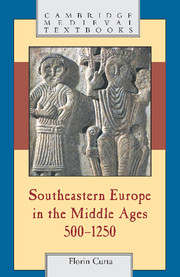Book contents
- Frontmatter
- Contents
- List of maps
- Acknowledgments
- Note on transliteration, names, dates, and words
- Chronology
- List of abbreviations
- Introduction
- 1 The end of Late Antiquity or the beginning of the Middle Ages (c. 500–c. 600)?
- 2 Southeast European “Dark Ages” (c. 600–c. 800)
- 3 The rise of new powers (800–900)
- 4 Iron century or golden age (900–1000)?
- 5 The first Byzantine century (1000–1100)
- 6 The second Byzantine century (1100–1200)
- 7 Between the Crusade and the Mongol invasion (1200–1250)
- 8 Conclusions and lingering questions
- Select Bibliography
- Index
- Cambridge Medieval Textbooks
1 - The end of Late Antiquity or the beginning of the Middle Ages (c. 500–c. 600)?
Published online by Cambridge University Press: 05 June 2012
- Frontmatter
- Contents
- List of maps
- Acknowledgments
- Note on transliteration, names, dates, and words
- Chronology
- List of abbreviations
- Introduction
- 1 The end of Late Antiquity or the beginning of the Middle Ages (c. 500–c. 600)?
- 2 Southeast European “Dark Ages” (c. 600–c. 800)
- 3 The rise of new powers (800–900)
- 4 Iron century or golden age (900–1000)?
- 5 The first Byzantine century (1000–1100)
- 6 The second Byzantine century (1100–1200)
- 7 Between the Crusade and the Mongol invasion (1200–1250)
- 8 Conclusions and lingering questions
- Select Bibliography
- Index
- Cambridge Medieval Textbooks
Summary
The idea of making the Danube the frontier of the Roman state goes back to Julius Caesar. For more than five centuries, the Roman power remained firmly entrenched in the Balkans and episodically (106–c. 275) expanded north of the Danube River into what is today western and southwestern Romania. A dense network of urban centers planted in the lowlands of the interior (especially in Thrace) or on the coasts sustained an administrative infrastructure that by and large remained unchanged from the late fourth to the late sixth century. The imaginary line dividing the Western from the Eastern Empire ran across the western half of the Balkan Peninsula, but the growing differences between the two political entities were barely visible in the region. The political developments associated with the rise of the Hunnic power in the Middle Danube region may explain, at least in part, why in the late antique Balkans the major contrast was north–south, not west–east. Nevertheless, despite the devastation brought in the early 400s to the northern provinces by the Hunnic raids, the natural and military borders continued to complement each other and to form an intricate matrix of Roman imperial self-definition. In the mid-sixth century, Procopius of Caesarea viewed the Danube as the “strongest possible line of defense” against barbarians, a line separating the “territory of the Romans, which is on the right” bank from barbarians living on its northern or left bank.
- Type
- Chapter
- Information
- Southeastern Europe in the Middle Ages, 500–1250 , pp. 39 - 69Publisher: Cambridge University PressPrint publication year: 2006

